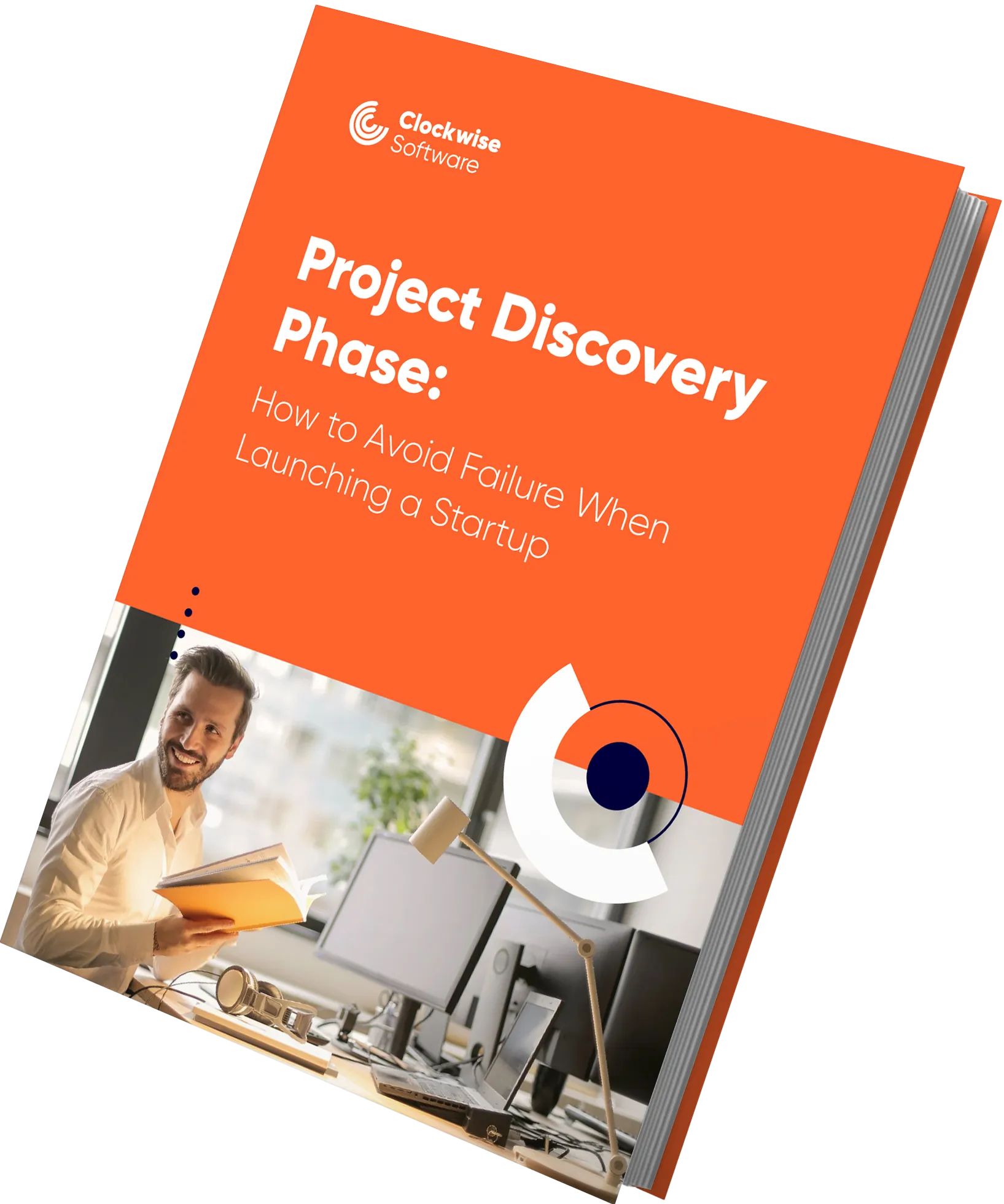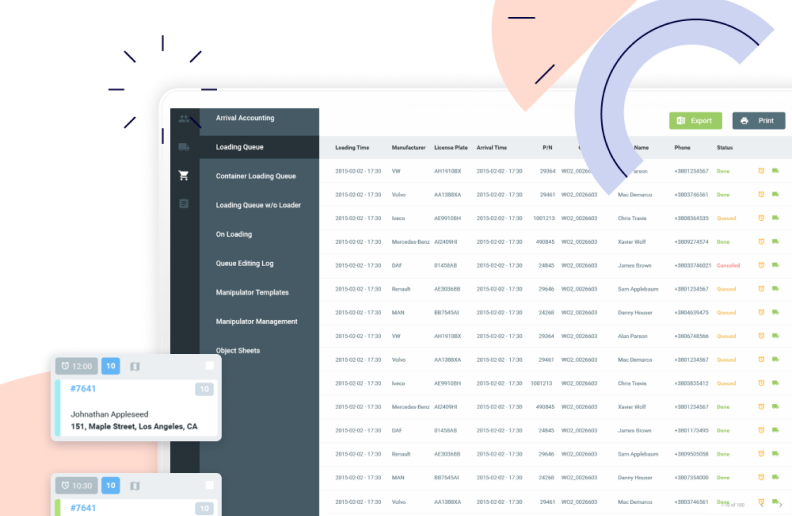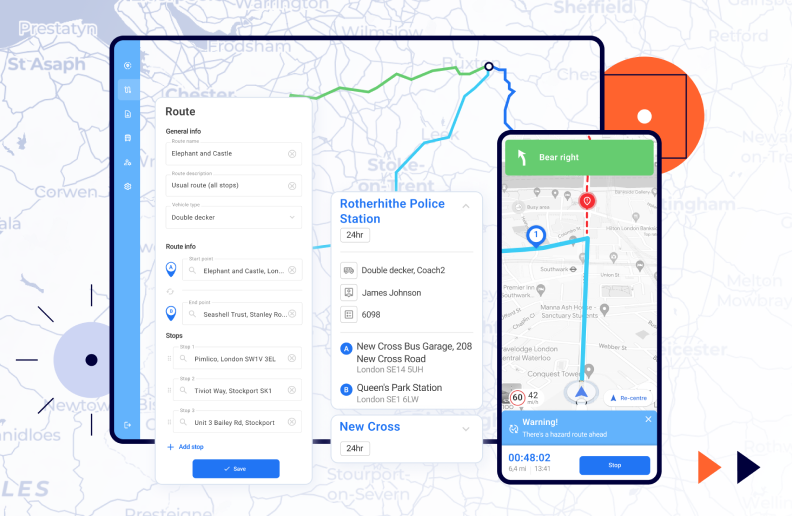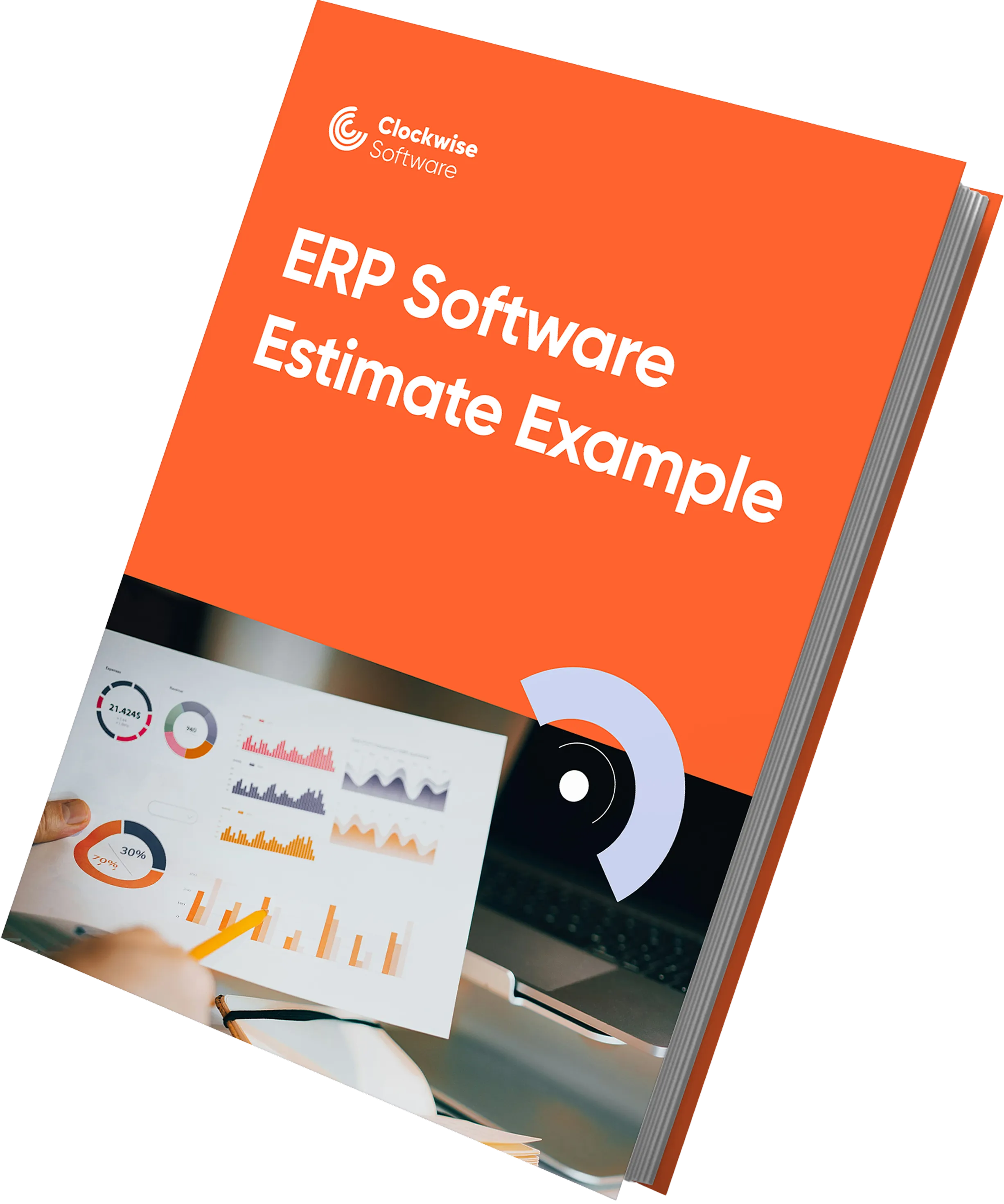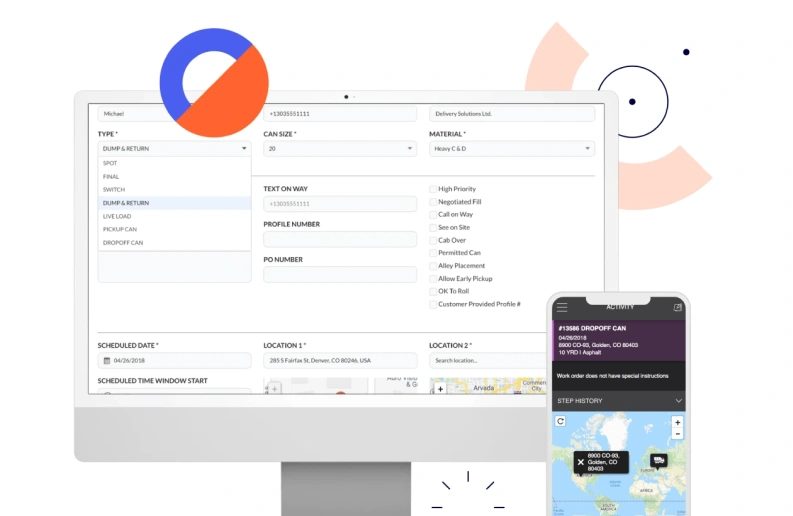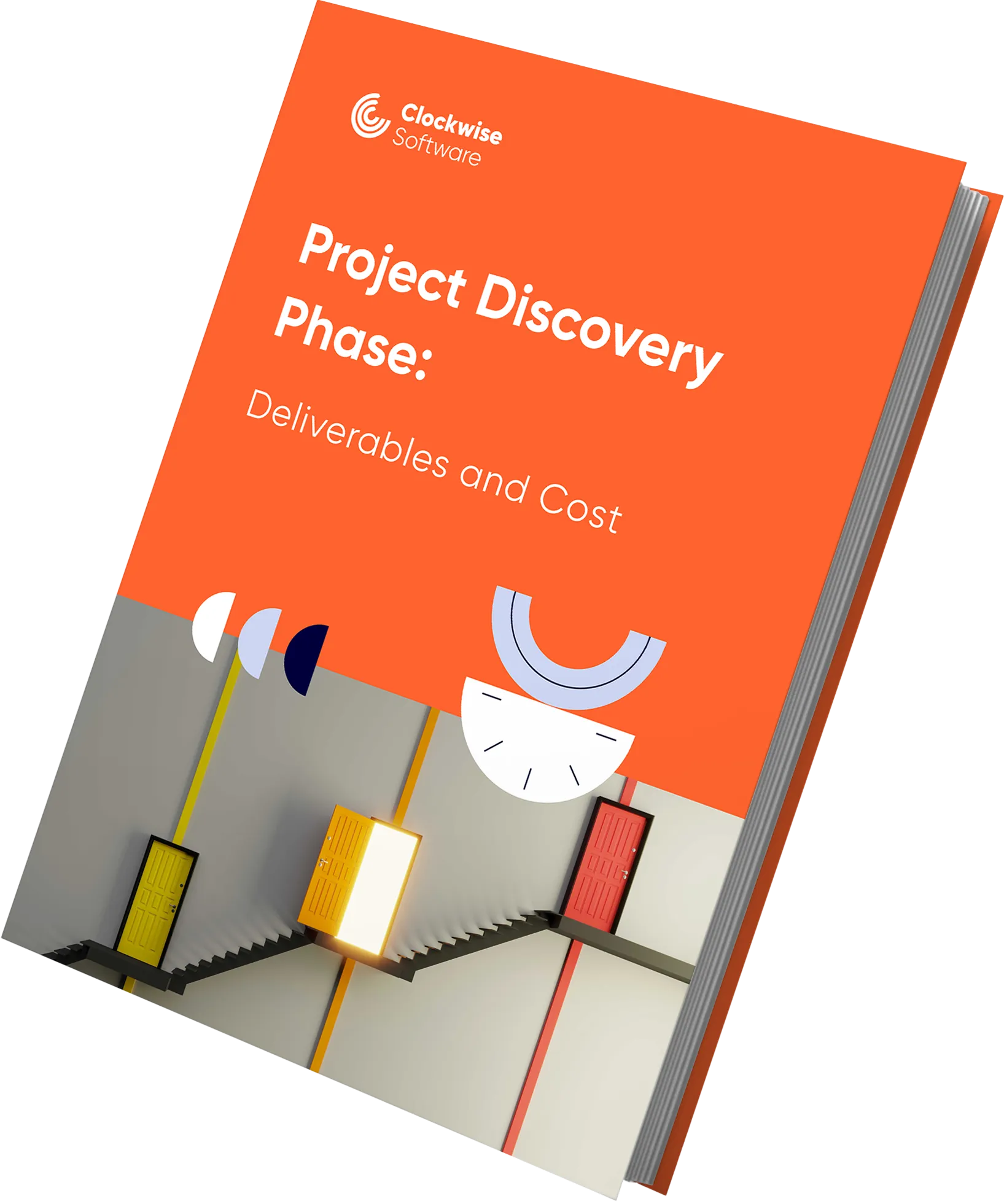ERP Software Development Guide: Steps, Estimates & Functionality Breakdown
Summarize:
Key takeaways
- When building an ERP, you need a discovery stage to plan your product in detail, a development stage to implement everything you’ve designed and planned, and post-release support to fix bugs and improve your platform.
- ERP software development takes 9+ months and costs $350,000+ depending on the scope of work. Sometimes, we start by building a minimum viable product (MVP). An MVP takes around 6 months to build and costs $150,000 to $200,000.
- Every detail matters when creating a custom ERP: the amount of data you want it to handle, future growth plans, industry-specific standards, your specific workflows, and critical integrations. To deliver exactly what you expect, we discuss all these details at the start and reflect them in your system’s architecture, design, and code.
- Risks are inevitable in ERP development — what matters is how you handle them. A risk mitigation plan, realistic and pessimistic estimates, an Agile development approach, and full transparency with our clients help us handle risks and minimize negative impacts on the project.
Custom ERP software needs several things to turn out great:
-
No-nonsense functionality — only the essentials, tailored to your business workflows
-
Integrations with other tools you use to avoid data loss and data silos
-
A design that keeps your team from getting lost in the maze of modules
-
Scalable infrastructure and an architecture built with your long-term goals in mind
… And someone who knows how to plan and implement all of this without causing lots of rework and shifts in development.
As a company that provides ERP software development services, we’ve worked on a bunch of ERP solutions for large manufacturers and transportation companies, real estate businesses, and municipal companies. And what we’ve built has actually worked for them. It has reduced errors by 75%, automated data processing, led to a 104% increase in delivery efficiency, and saved lots of time — and these are just a few of the results we know about.
Here, we want to give you an inside look into ERP software development. You will find out:
- What the development process involves
- How long it takes and how much it costs to build an ERP system
- What we’ve built for our clients and how it has covered their needs
Let’s start.
ERP software development process in a nutshell
First things first: let’s talk about processes. Here are 3 stages to expect when starting ERP software development:
1. Project discovery stage to make all technical decisions and development plans. During this stage, we usually explore your business processes and needs, decide on your ERP’s functionality, architecture, and design, estimate the scope of work, and plan execution.
2. Development stage to implement every ERP feature, focusing on coding, testing, and deployment. We build in sprints, working on functionality based on priorities we set with you on the discovery. You can see mid-project results as we sync with you regularly, and course-correct if features or priorities need changes.
3. Post-release support and improvement to resolve issues and improve your ERP to match ongoing needs by working on new features or upgrading infrastructure. This stage is optional — we can keep supporting your system or hand off everything to your in-house team with clear documentation.
We have a lot to say about the work that happens behind a successful ERP, but let’s step back for a moment to look at something we’re sure you’re interested in — cost estimate examples.
Rough cost estimates to build an ERP system
ERP software costs vary greatly depending on the scope — are you building a full-scale platform with dozens of modules or something more modest? For example, costs typically start at $150,000 for a minimum viable product (MVP) and can reach $500,000+ for large, complex ERP systems.
Here are rough cost examples to give you an idea of what different scopes typically cost to design, build, and release.
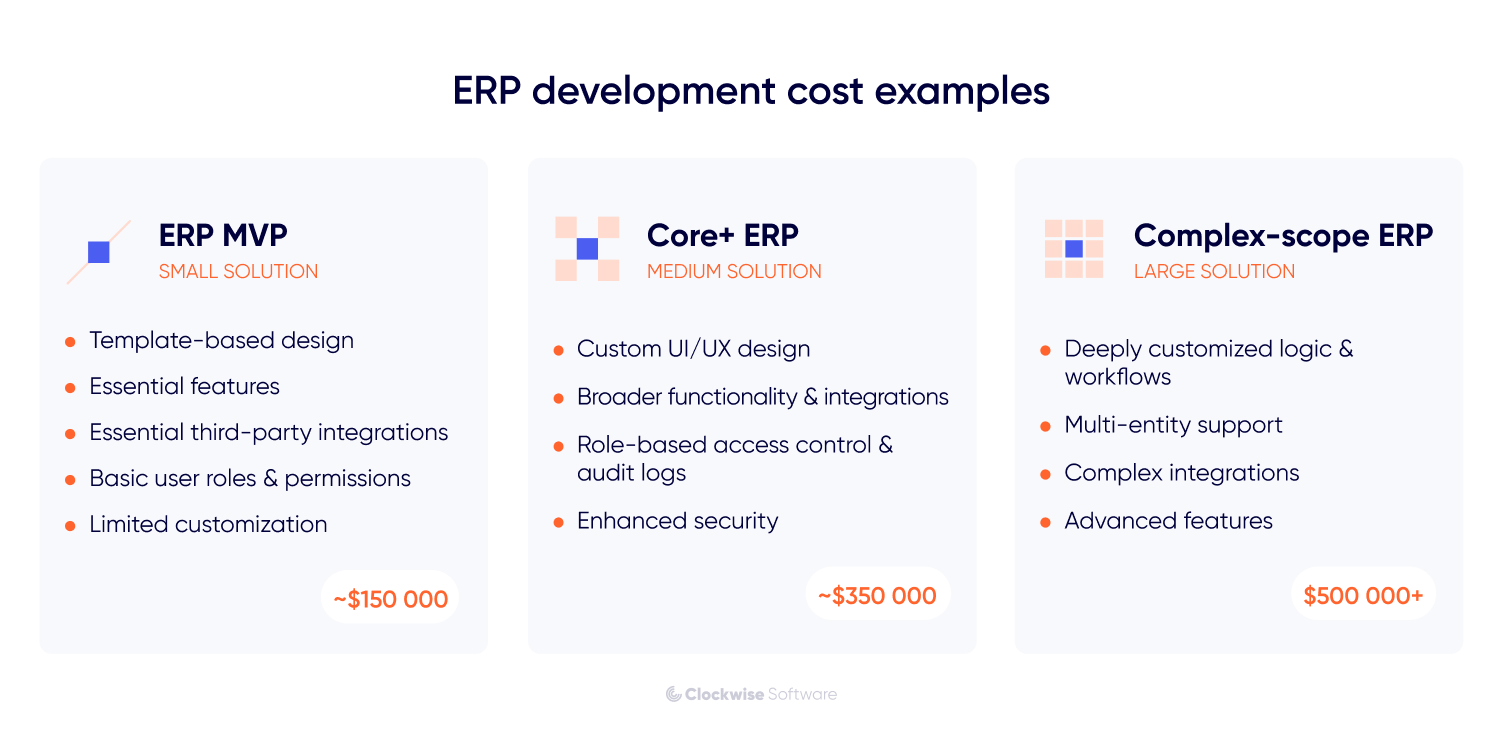
As for the time to build, an MVP can take around 6 months to build, while a full-featured ERP system can take 9-12+ months to develop and release. Again, the exact time depends on the scope of work.
Need more precise figures for your ERP idea?
Let’s schedule a call — with more details on your idea, we’ll sketch out the scope and provide an estimate you can work with.
Now, let’s break down how the development itself works — what’s built and how we approach it.
(If you’re looking for the discovery stage info, scroll down to the end of this guide. We just figured you'd rather see development and functionality first.)
Development process: Functionality overview & a detailed cost breakdown
The team is assembled, and it’s time to build — here’s a typical flow when we move into ERP development:
- Application bootstrapping
We start by laying down the foundation for the infrastructure, frontend, and backend. From configuring version control to setting up repositories, establishing development environments, and implementing continuous integration and deployment pipelines, this step helps us smoothly move into development.
- Frontend development
Frontend developers create the interface designed by the UI/UX specialist during project discovery. They implement every part of your ERP and make sure that visual components are responsive and work as you want them to — that pop-up windows appear when you need them, clicks move you to the right page, and data tables are easy to filter and sort for quick insights.
- Backend development
Backend specialists develop your ERP system’s core logic: managing data, processing user requests, communicating with databases, and multiple other things a user doesn’t see. They also set up APIs to connect your ERP with external tools and services. We focus heavily on performance, ensuring your system can handle peak loads without slowing down.
- Testing, regression, and stabilization
Our QA engineers test each feature once it is complete and make sure that everything aligns with the requirements. All issues are reported back to developers and fixed.
When we finish with all features for the initial product version, we do regression testing to check that new features haven’t disrupted previously built functionality.
Stabilization comes next, where we refine and optimize your ERP after major development and testing are complete. This is like polishing your system. We resolve any lingering bugs and inconsistencies across modules, fine-tune performance, and optimize data handling — everything to make sure your ERP runs smoothly and reliably.
- User acceptance testing
Yes, here goes another test. But this time, the end users are the ones to test the ERP. You or your team will interact with the system, see how it works, and confirm whether the ERP meets your expectations. We’ll gather your feedback and fix the system if needed.
- Deployment
Once testing is complete, we set up your ERP system for actual use. After deployment, there can be some more testing just to double-check everything, and finally, you’ll get your system live.
Read also: Custom Software Development Guide
We divide ERP software development into iterations that last 2-4 weeks each. During every iteration, we focus on a few features, and once they’re complete, we move to the next iteration. This allows us to stay flexible, promptly pinpoint issues and changes, and reduce software development costs by avoiding rework at the end of development.
But let’s talk more about the result of the ERP development stage: functionality.
ERP system functionality
One size never fits all when it comes to ERP systems. That’s where custom builds make all the difference: you get just the features you need, tailored to fit your exact workflows. No unnecessary extras that would turn your system into another generic (and clunky) solution.
One example from our experience is an ERP system for the Ukrainian manufacturing company UDK, part of a large corporation with 2M+ employees. The company’s employees struggled with errors as numerous sales, logistics, and reporting tasks were done manually. On top of that, one process might involve around 6 specialists, making it time-consuming to complete.
The ERP solution we built reduced the number of errors by 75% and improved delivery efficiency by 104%. Here’s what functionality helped to achieve this:
| Functionality | |
| General | Authorization, MFA
Search and filters |
| Admin panel | Dashboard
Client registry Counterparty registry System statistics Notification management User management |
| Client account | Client profile
Notifications News Product catalog Product order placement & details Shipment order placement & details Documentation view |
| Order management | Order list
Order details Order confirmation/ termination |
| Shipment management | Shipment order list
Automated delivery contractor selection Shipment details & tracking |
| Warehouse logistics | Inventory management (considering orders & production schedule)
Calculation of vehicle loading schedule |
| Logistics | Calculation of product delivery schedule
Vehicle composition based on loading/unloading type and delivery points Calculation of optimal order distribution across vehicles Delivery schedule builder for large orders |
| Financial management | Automated invoicing
Payment status notifications Client account balance management, discounts, bonuses, credit limits |
| Document module | Document upload / download
Document storage |
| Integrations | Accounting system
Map services Messenger Email service SMS service |
We focused on automating tasks that were performed manually and organizing everything into logical modules. At the same time, we didn’t create alternatives for systems the client was satisfied with (such as their accounting system). Instead, we integrated them with the ERP to enable data exchange and automate some tasks like invoicing.
As we did for UDK, we will fully tailor your ERP’s functionality to your wants and needs. Let’s look in detail at functionalities we’ve built and how we’ve matched them to our clients’ processes.
- Order management module
We pack this module with everything your team needs to manage orders from start to finish without switching between several tools. Functionality can include:
- An order list that automatically updates as you get new orders
- Order profiles with client information, order statuses, and communication tools
- Storage with order-related documentation
- Collaboration tools so you can assign managers to specific orders
We focus on details, making sure you get all the data you need in one module and can manage orders with ease. Whether as part of a larger ERP platform or a standalone order management software solution, this module streamlines order tracking, improves visibility, and enhances operational efficiency.
For example, when working on an ERP system for Vialoop, a facility management aggregator, we implemented an email parser as the client receives most of their orders by email. On another ERP software development project, a platform for real estate company StoneBay, we connected to third-party real estate marketplaces via APIs, automating lead collection and sorting.
Read also: How to Build an ERP System for Real Estate
- Logistics module
This module gathers everything your team needs to manage and track deliveries and drivers:
- Delivery order details
- Automated or manual driver selection
- Real-time delivery tracking
- Notifications and status updates
When it comes to simplifying route planning, maps are a must in our toolkit.
For instance, a London transportation company that we worked with needed a way to plan routes for massive vehicles. We set them up with Azure Maps, customizing it to show the best routes for massive vehicles. We also implemented features for operators to manually mark road hazards that typical map services might miss, and made the routes update in real time.
We also built a mobile app for drivers that is fully synced with the main system. Now, when drivers are on the road, they get instant route updates and safety notifications from operators.
- Analytics and reporting module
Data analysis and visualization in charts and graphs, interactive dashboards that you can customize to your needs, report templates and the ability to export reports in PDF, XLS, and other formats — we can create it all within one module.
We built a similar module when working on logistics-focused software for Exertis. Features for creating visual dashboards, downloading tables and graphs, and importing and exporting various reports helped end users reduce the time they spent analyzing and structuring data on transportation processes.
- Human resources module
A human resources module can organize and keep employee data in one space, allowing you to manage things like time tracking and attendance, payroll, performance reviews, and employee experience.
We can also offer functionality for time tracking, attendance, and workspace surveillance. We created a video surveillance solution for our client’s factory that visualizes real-time data from various sensors in one dashboard, automatically recognizes suspicious activity, and sends notifications to responsible managers.
- Project management module
If your work involves dealing with continuous projects, we can create a place to centralize all project management activities:
- Project progress tracking with a timeline and project workflow visualization board
- Collaboration tools to assign team members to tasks and communicate with stakeholders
- Documentation storage for each project
We created similar functionality for an Irish municipal company. Along with project management functionality, we delivered great security with different user roles to limit what users with different access rights can view within the system.
- Financial management module
A financial module, integrated with other modules in your ERP and an external accounting system, becomes a one-stop hub for financial management. This module can automatically pull in invoices, expenses, and other financial data, categorize it, and store it so you can effortlessly handle financial tasks with all data in one place:
- Bookkeeping with data feeds from other modules and external tools
- Automated invoices
- Payments management
- Generation of financial statements
- Integrations
Whether you need to integrate maps or payment gateways, complex systems like NetSuite, or custom tools that don’t have APIs or documentation, we can handle it.
Once we understand what you need these integrations for, we’ll configure them to meet your needs: to maintain real-time data exchange, access external services like maps within your ERP, or automate certain tasks.
For example, we integrated Vialoop’s ERP with NetSuite automatic data sync and with a tax calculator to automate calculations when creating financial statements.
For UDK, we integrated the ERP with a custom accounting system for automated invoicing and with a tender system that selects contractors for shipment orders. Once a contractor is selected, this information automatically appears in the ERP.
These are just a few examples of what we have done and what we can do for your ERP. When building your system, we’ll make sure that features match your ideal workflow and integrate smoothly with external systems.
Get functionality that works exactly how you need it.
No unnecessary extras, only tailored features — we fine-tune functionality to your workflows. Book a free call to discuss your needs.
Development cost and timeline
The cost of custom ERP software development starts at $350,000. Building custom ERP systems takes 9 months or longer — everything depends on the scope of work.
Check an ERP functionality breakdown with approximate estimates based on our projects: basic features, 4 frequently requested modules, and 4 integrations. So you can see what shapes the cost of custom software development.
For ERP systems with broader functionality, development will cost $500,000+ and take a year or longer.
We can also start by building a minimum viable product (MVP). An MVP will include some general features and a few critical modules. It’s a great option if you have urgent deadlines for optimizing certain workflows or want to test the system within your organization before moving further with development. Depending on the scope, developing an MVP for an ERP system will cost $150,000 to $200,000 and take around 6 months.
Post-release support and improvement
After the ERP system’s release, our team doesn’t just sit back and relax. We start the next stage of the software product lifecycle, focusing on:
- Providing technical support. We’ll fix bugs and ensure that everything works smoothly.
- Improving functionality. Whether you decide to add new modules and integrations or want to redesign some features to tailor them to the current needs of end users, our team will take on these tasks, plan the scope of work, and implement it.
- Scaling infrastructure resources. We know that your needs can evolve, and we are ready to adjust the system to new demands. We create a scalable infrastructure from the start, so it won’t be a problem to set up additional resources to handle a higher system load.
For example, after releasing a solution for a waste transportation company in Denver, we worked on adjusting the design based on user feedback and improving load time for maps that were full of custom components.
Cost of post-release support and improvement
The cost of post-release support and subsequent ERP development iterations depends on the scope of work and how fast you want it to be finished. We’ll provide you with a work breakdown structure (WBS) and precise estimates before each iteration. But to give you a sense of what to expect, here are some approximate figures for a monthly ERP software development budget:
- If you plan to implement a few features or just need us to support existing functionality and don’t have urgent deadlines, the monthly budget can start at $12,000.
- If you plan to implement several new features and have urgent deadlines, we’ll involve more developers in the process. The monthly budget for these development iterations will be around $48,000.
| Team composition | Monthly budget | |
| Small scope of work & standard timeline |
|
$12,000 |
| Large scope of work & urgent timeframe |
|
$48,000 |
| * On-demand involvement | ||
Improving your existing ERP system
We can help you adjust your software to meet evolving needs or simply change something that no longer works for your team. Even if you’ve initially built the system with another vendor or it has been years since you worked with Clockwise, you can contact us and we will help you to optimize your platform.
This was exactly the case with UDK. We restarted our cooperation 9 years after we built an ERP system for them, and now we’re working on a new ERP system built with modern frameworks, a multitenancy architecture, and features adjusted to the company’s new processes.
If your system struggles with slow processing and data delays, we will refactor backend components and optimize database queries.
If you want to add new functionality and integrations, we will plan the scope of work and implement it.
If you need to rewrite your solution using another framework, migrate the system to a cloud environment, or implement multi-tenancy to prepare your ERP for licensing, we will assess your system, choose a new technical approach, and implement it.
Cooperation options we provide
To help you with custom ERP software development, we can offer 3 cooperation options:
- Product development service
You can outsource the entire ERP development project to our team. With software product development services, we cover all development steps, from discovery to deployment, post-release support, and continuous system improvement.
We’ll give you regular progress updates and confirm all key decisions with you. All other development processes will be fully handled by us, freeing up your time to focus on your business strategy and other high-priority tasks.
- Dedicated team services
Our dedicated team services can help you augment your existing team if you lack specialists with expertise in developing ERP systems or need to speed up the process. You can hire dedicated software developers to join your in-house team on a project basis to fill any skill gaps and ensure smooth ERP software development.
- Software development consulting
If you’re just starting out and want to explore options to tackle your challenges, software development consulting is a great first step. We’ll dive into your specific needs and objectives and recommend the right technical approach.
Behind the scenes: How we set up for on-track, on-budget execution
Alright, now that you’ve seen what goes into ERP development, it’s clear this isn’t light work. So, how do we keep it on track, on budget, and free from expensive backtracking? The answer is a project discovery stage.
This stage isn’t just about planning — it’s about protecting your investments. Overlooking details at the start could cost you an extra $30,000+ later on. That’s why we always start with preparation to minimize costly mid-project rework.
During the project discovery stage, our business analyst, project manager, UI/UX designer, and software architect will focus on several tasks:
1. Understanding your business processes
At the start, we will set up meetings with you to discuss your business processes and needs. Our goal is to understand your existing workflow, any bottlenecks you have, and what you are trying to achieve.
We’ll also ask you questions like:
- Who are the key users of the system, and what level of access should each user group have?
- Are there critical integrations we need to take care of?
- What data will you need to migrate from legacy systems?
- Do you have any specific compliance and security requirements?
- What is your long-term vision for the ERP system?
Your answers will set the stage for the next step: defining your ERP system’s functionality.
2. Shape ERP functionality and define requirements
Knowing your business context and needs in detail, it’s time to map out your ERP system.
We outline functionality and define system requirements so the final product will meet all your needs. You’ll get a detailed description of your ERP in multiple documents and visuals, including:
- Business process diagrams that visualize the workflows within your system
- Use cases or user stories that detail the system’s responses to users’ actions, data processing and management, and interactions with external systems
- Data dictionary or data flow diagrams that contain requirements for data involved in each process
- Non-functional requirements that describe security, usability, and other standards
- Wireframes that visualize your ERP’s interface and its key elements
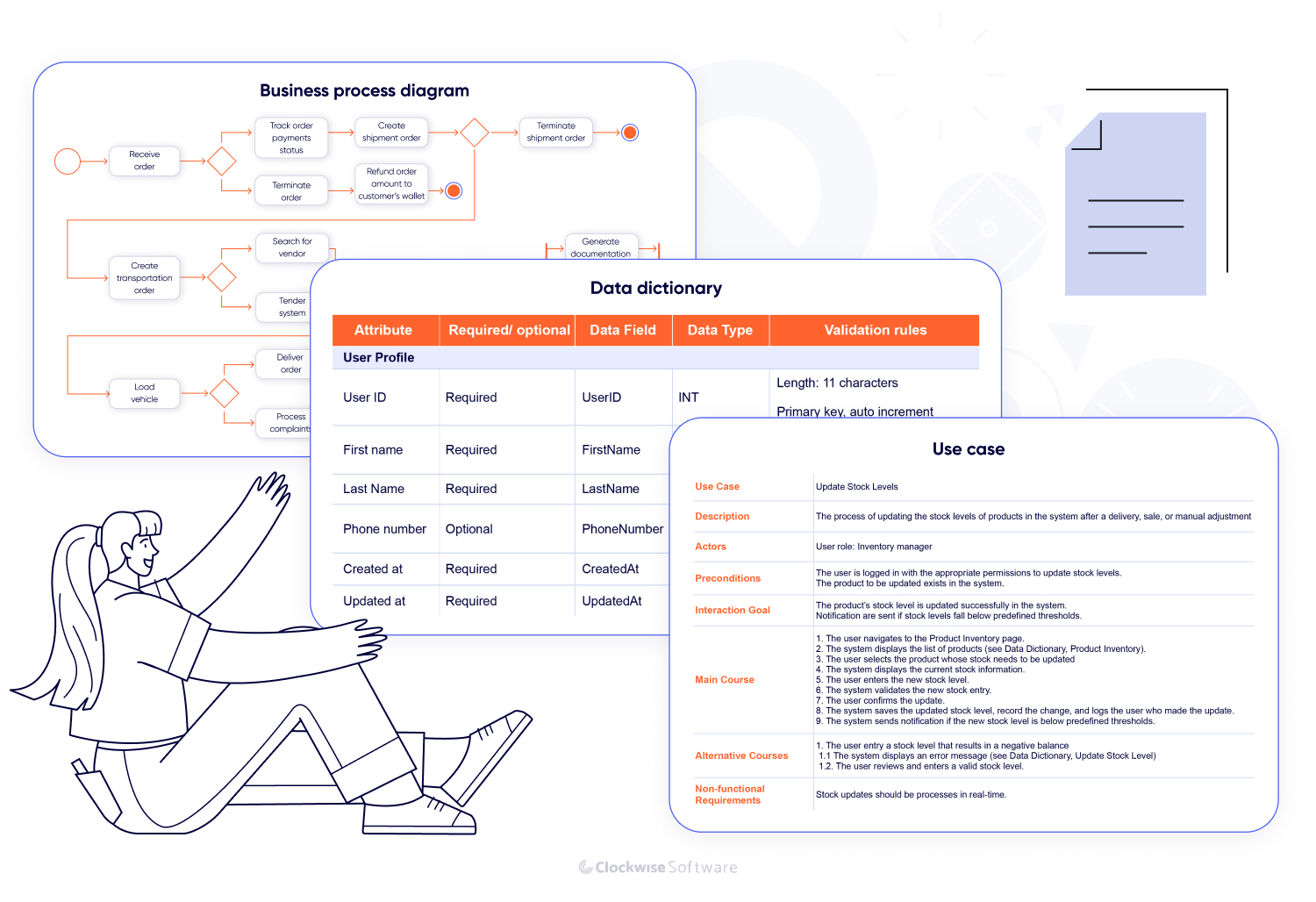
For our development team, system requirements serve as a blueprint for what to build. For you, they prove that we understand your needs and have shaped a system that will match your expectations. Plus, with everything clearly outlined at the start, you will avoid wasting money on unnecessary features or huge changes down the road.
3. Explore technical specifics, risks, and limitations
The next task is to consider the specifics of implementing your system and figure out what risks may exist. We explore technical ways to meet your security needs, challenges with data migration, and many other considerations depending on your project needs.
What we always check for ERP projects is integrations with external tools and their APIs.
Different integrations have different corner cases and limitations. We don’t want them to create issues during development. Our software architect explores available information about required APIs and tests how they work before development starts.
One way to do this is by creating a proof of concept. This small-scale implementation imitates how everything will work in real-life scenarios and helps us identify risks and limitations. In some cases, it’s also a way to test different services and choose the optimal one for your business needs.
4. Create a UI/UX design
Remember the wireframes we did earlier? It’s time to turn them into designed screens.
Our designer will discuss your preferences with you and develop a UI/UX concept that matches your vision. Then, we will use this concept to design the entire user interface.
We also turn designed screens into an interactive prototype that helps you visualize how users will interact with the app and where each click leads. Once ready, we’ll walk you through screens and the prototype to make sure everything is tailored to your team’s workflows and looks exactly as you want.
5. Choose the tech stack and design the architecture
Next, we choose the architecture, tech stack, and tools that will keep your ERP system secure, flexible, and ready to scale. Here are a few insights on what we consider for custom ERP software development:
Development frameworks. JavaScript is our top choice for web development — it’s versatile and backed by a rich ecosystem of libraries and frameworks, making it perfect for building complex web applications.
On the front end, we often work with React, Angular, or Vue.js. For the back end, we rely on Express.js or Nest.js. And when it comes to PHP, we have solid experience with Laravel.
Architecture. When designing a complex system like an ERP, the key architectural trade-off lies between a monolithic and microservices architecture. A monolithic architecture is easy to build and deploy, but it can get tricky to manage and scale as the system grows. Microservices, while more complex up front, offer better scalability and easier maintenance in the long run.
From what we’ve seen, a service-oriented approach works best for ERP systems. This breaks the system into medium-sized services, each handling a specific task: an authentication API, a customer API, integrations with external tools like your accounting system, and so on.
The goal here is to find the balance between scalability, flexibility, and maintainability. That’s why we prefer to design all services using a layered architecture — it keeps them tidy, scalable, and easy to enhance over time.
Scalable infrastructure. The scalability of infrastructure depends on the particular service. We use cloud platforms like AWS, Azure, and Google Cloud to build scalable and reliable infrastructure. These services offer a wide range of tools for quick and efficient ERP development, deployment, and scaling.
For example, on AWS, we’ve worked with Elastic Beanstalk, which supports auto-scaling and load balancing, and AWS Lambda, which automatically scales with incoming requests.
Plus, we rely on Infrastructure as Code (IaC) tools like Terraform and AWS CloudFormation to map out and manage our infrastructure. By keeping configurations in version control, we make it easy to replicate setups across environments.
System protection. Security isn’t just a checkbox for us — we take care of it from the start. Data encryption, role-based access, and built-in security measures from services like AWS, Google Cloud, or Azure are key measures for protecting data and the entire system. Plus, we take care of automated backups with services like AWS Backup and Google Cloud Storage.
Have any specific security requirements? No problem. We will consider additional options to protect your system.
System performance monitoring. We choose tools like AWS CloudWatch or Azure Monitor for real-time insights into system performance and to catch any issues before they escalate.
Beyond these built-in tools, we also use third-party solutions like New Relic and Sentry. They are game-changers for precisely spotting, tracking, and categorizing issues.
Database. The choice of database impacts how we structure data and how fast it can be retrieved or updated. PostgreSQL and MySQL work well for handling structured data, while NoSQL databases like MongoDB are good for handling more complex and unstructured data.
We’ll choose the optimal technical approach for implementing your ERP and communicate our decisions to you, making sure that the system architecture aligns with your business needs and that we don’t miss any requirements.
Get a detailed technical approach to implement your system
We plan every detail so you get exactly what you need — no trade-offs. Let’s discuss what you want to build on a free call.
6. Estimate everything and plan development
We’re coming to the finish line of the discovery stage. When all system details are in place, it’s time to refine documentation and plan development. Here’s what you get in this step:
- Risk register with possible technical, organizational, and external software development risks and a plan to mitigate them
- Work breakdown structure (WBS) that details modules and features of your ERP, as well as tasks for building each feature and optimistic and pessimistic time estimates
- Cost estimate for building the initial product
- Project timeline that visualizes the development duration and team members’ involvement
- Project roadmap with milestones, goals, and tasks
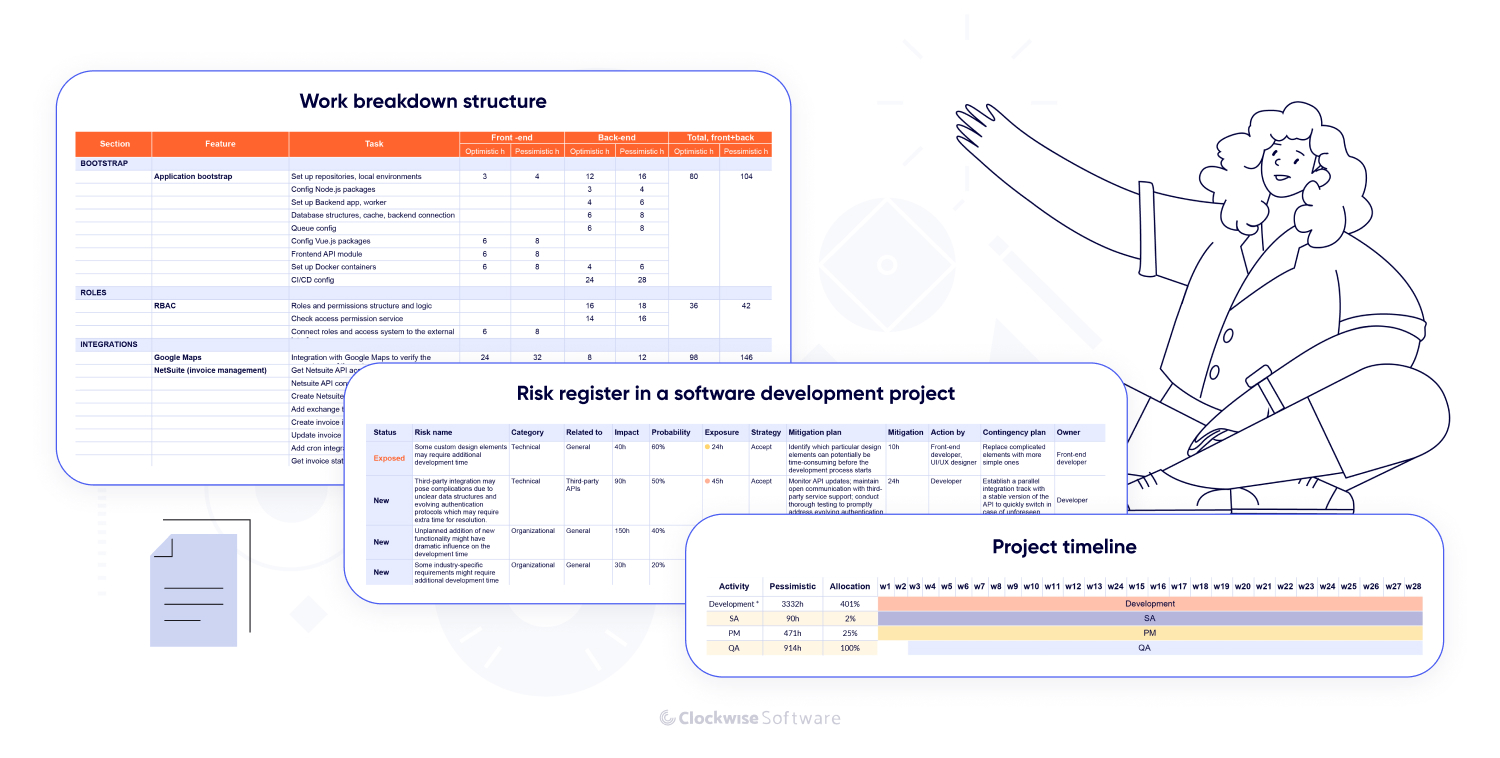
By the end of the discovery phase, you’ll have a detailed description of your ERP system along with estimates and a plan on how to make ERP software you want.
But here is something we want you to know from the start:
ERP systems are rarely built on a fixed budget.
They’re complex and take months (sometimes years) to develop, so not every detail will remain the same as we move through the project. Unforeseen changes can arise and affect the timeline and budget. That’s why we create both optimistic and pessimistic estimates and communicate every detail with you. But it’s important to be prepared for adjustments along the way.
Costs and timelines for a project discovery service
Project discovery for an ERP system takes 4 to 10 weeks. The more complex the system you need, the more time it will take for our team to define all its details. The scope of work also impacts the discovery cost, which varies from $12,000 to $25,000.
You can explore detailed information about the time, cost, and deliverables of a project discovery phase in our whitepaper.
To sum up
In custom ERP software development, great results come from several things:
- Tailoring each feature to your specific business needs and not settling for one-size-fits-all solutions
- Solid planning at the start — otherwise, missed details, a poor technical approach, and overlooked risks can lead to serious re-dos (and extra costs) later
- Being flexible and ready to adjust along the way to meet new needs and overcome challenges
Partnering with a team that understands this and knows how to build an ERP from first-hand experience will result in a less stressful development process and an ERP solution that covers all your processes and works exactly as you need it.
If you feel like our expertise matches your needs, we’ll be glad to hear about your vision for an ERP and help you implement it.
It’s time. Get the ERP that finally works your way.
75% fewer errors and 100% automation of many routine tasks are just two of the results our clients have achieved. We are ready to help you do the same. Let’s start with a free call.
FAQ
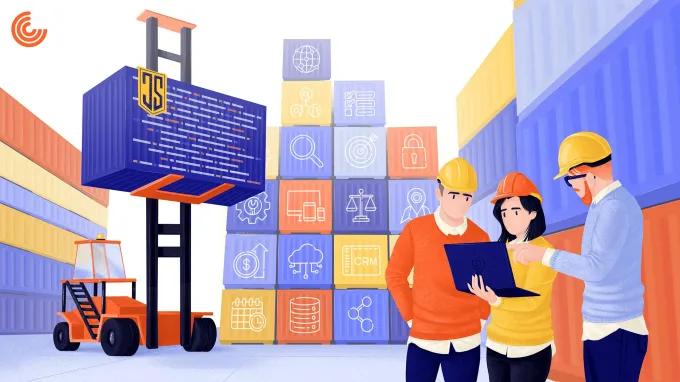
Any questions unanswered?
Let's discuss them
